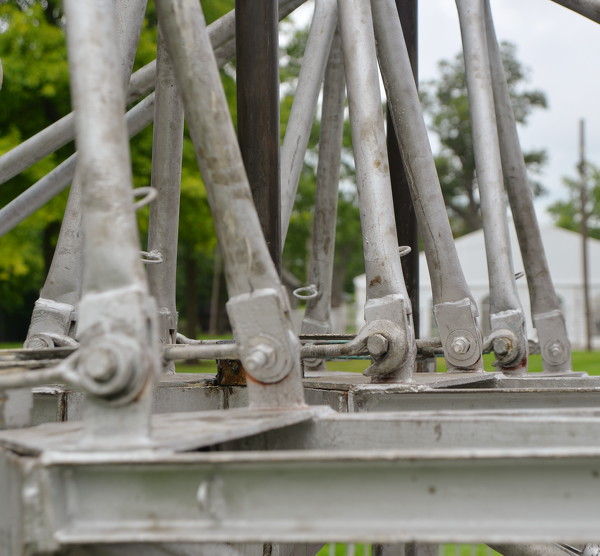
Passengers scream as they turn upside down on the Fireball ride at the 2022 Mercer County Fair in Celina.
County fairs are just around the corner in Wapakoneta and Celina, and state inspectors will be on the grounds to verify amusement rides are working properly and safe for fairgoers to board.
They'll also closely examine darts, basketballs and other components of midway games of skills to ensure they're not crooked.
The Ohio Department of Agriculture's Division of Amusement Ride Safety, which is tasked with carrying out permitting and inspection, is confident in its regulatory oversight process.
"I firmly believe that the state of Ohio has one of the strongest amusement ride safety programs in the country based on the level of regulation that we have, the quality of the industry and the seriousness they take in ride safety, as well as the credentials of our inspectors," insisted David Miran, the agency's deputy director of regulatory programs.
While the state has long had one of the nation's more robust ride inspection programs - nine states don't require any government scrutiny as of 2021 - Ohio lawmakers spent more than a year crafting a plan to increase oversight.
Their action came in the wake of a 2017 accident at the Ohio State Fair that killed Tyler Jarrell, an 18-year-old Marine enlistee, and left four others with life-changing injuries.
Called "Tyler's Law," it requires more mandatory inspections for big attractions and makes owners maintain repair and travel records.

Riders on a swing look over the Mercer County Fairgrounds from above.
The Division of Amusement Ride Safety has employees who regularly inspect more than 4,000 rides across the state. Rides require an annual permit and follow-up inspections, Miran said.
"Some of these bigger rides, especially the county fair rides, we inspect them in the spring and in the winter, depending, again, when they're scheduled," he said. "But we see them multiple times a year - six, seven, eight, nine, ten times a year, just because they're traveling that county fair circuit."
The agency shows up to all 94 county and independent agricultural fairs and the Ohio State Fair to inspect rides that are usually licensed to operate ahead of time.
"Sometimes if it's an out-of-state company, that fair will be the first time that they're operating (in Ohio), so those will be initial inspections," Miran noted. "In order to have a kid hop on that ride, they have to be inspected and have to have a permit."
The number of state employees and duration of the inspection process depends on the complexity and amount of rides at a fair, said Miran. Last week was one of the biggest of the year for state inspectors who appeared at six or seven fairs.
But generally speaking, a pair of employees will show up to each county fair to conduct a two-pronged approach to ride inspection.

Rides for the upcoming fairs in Wapakoneta and Celina wait to be set up into large and thrilling amusements for fair-goers.
First is the static inspection of rides that are set up or in the process of going up, Miran said. Employees want to verify the rides are assembled in line with the manufacturer's requirements.
"We're looking at bolts. We're looking at the structural pieces. We're looking for cracks and corrosion and just going through making sure that as the ride is sitting still it has been set up in accordance with those standards and is safe for people to get on board," he said.
The second part of the inspection centers on rider operation.
"That's where the ride company actually goes out and operates the ride and we observe that," Miran said. "They're making sure that when it's actually operating it's smooth, it's operating as it should, the ride operators are checking things for, like, electrical components, making sure that the emergency stop button works, those sorts of things, so that when people are actually on the ride, it's operating in a safe and sound manner," he explained.
Common minor issues that may crop up during ride inspection such as missing safety pins or frayed seatbelts, Miran said.
"We don't want to shut down the entire ride for one seat, so what we'll do is we'll put a tag on it or something of that nature and say, 'Hey, you can operate the ride but you can't put anybody in seat No. 17 until you replace it with a new seatbelt," he said.
Smaller issues can usually be remedied, allowing for full operation.
On the other hand, more serious issues such as cracks, metal fatigue and corrosion take much longer to address.
"You have to get manufacturer's approval or third-party engineer's approval or specific procedures to address those issues," Miran said. "It's just like your car, right? You could have a blown tire. It could need a new spark plug or it could need a brand new engine. They're machines and they operate like machines."

Rides for the upcoming fairs in Wapakoneta and Celina wait to be set up into large and thrilling amusements for fair-goers.
Concessions such as midway games of skill are also put through the wringer. The agency follows "very prescriptive rules," to confirm fair play, Miran said. Annually, it conducts more than 7,000 concession inspections at fairs.
"For a three-point shot, we're checking the rim size. We're checking the air pressure in the basketball," he said. "(For a dart game), we're checking the darts to make sure that they're straight and level. We only allow a particular kind of darts that the feathers can't be damaged."
For nearly two decades, the Mercer County Fair has contracted ride vendor Poor Jack's Amusements based out of Milton, Indiana. Neither fair manager Cara Muhlenkamp nor Miran could offhand think of having had any issues with the company.
"Every year when the ride inspectors come, they will tell us that you cannot get a better ride company to work with," Muhlenkamp said. "They take safety very seriously. They are courteous, and the workers are very good to work with."
Muhlenkamp also commented on the ride and game inspection process at the fair, which typically lasts 12 to 13 hours.
"It's nothing to see them climbing on top and around the rides to underneath. They inspect anywhere from the paint, to the welds, make sure there's no rust on them. It's a very intricate process that they go through," she said. "(Afterward) they do a meeting with myself and usually the (fair board) president and vice president to go over everything."

Rides for the upcoming fairs in Wapakoneta and Celina wait to be set up into large and thrilling amusements for fair-goers.
Ride and game inspections aren't just confined to county fairs.
"Every amusement ride in the state of Ohio must obtain a permit and be inspected by the Ohio Department of Agriculture," Miran said. "It includes everything from a roller coaster to an inflatable device at Cedar Point or Kings Island to your local church event or even backyard birthday parties."
Miran said he lets his kids go on rides knowing they are inspected by some of the most highly-credentialed professionals in the world.
"Everyone in the this industry, their No. I mission is safety," he said. "Our guys are in there a lot, whether it be Cedar Point, Kings Island or the Columbus Zoo, or any of the larger amusement parks."
-The Associated Press contributed to this article.

Rides for the upcoming fairs in Wapakoneta and Celina wait to be set up into large and thrilling amusements for fair-goers.